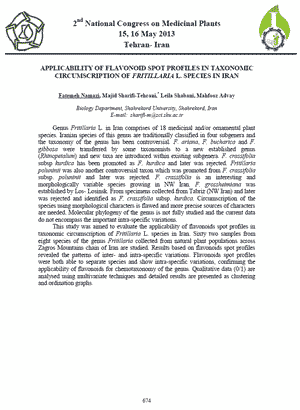NEWS 2012
Applicability of Flavonoid Spot Profiles in Taxonomic Circumscription of Fritillaria L. Species in Iran
Fatemeh NAMAZI, Majid SHARIFI-TEHRANI, Leila SHABANI, Mahfooz ADVAY
2nd National Congress on Medicinal Plants, Tehran, Iran (2013)
15 & 16 May Poster
Biology Department, Shahrekord University, Shahrekord, Iran

Abstract
Genus Fritillaria L. in Iran comprises of 18 medicinal and/or ornamental plant species. Iranian species of this genus are traditionally classified in four subgenera and the taxonomy of the genus has been controversial. F. ariana, F. bucharica and F. gibbosa were transferred by some taxonomists to a new established genus (Rhinopetalum) and new taxa are introduced within existing subgenera. F. crassifolia subsp kurdica has been promoted as F. kurdica and later was rejected. Fritillaria poluninii was also another controversial taxon which was promoted from F. crassifolia subsp. poluninii and later was rejected. F. crassifolia is an interesting and morphologically variable species growing in NW Iran. F. grossheimiana was established by Los- Losinsk. From specimens collected from Tabriz (NW Iran) and later was rejected and identified as F. crassifolia subsp. kurdica. Circumscription of the species using morphological characters is flawed and more precise sources of characters are needed. Molecular phylogeny of the genus is not fully studied and the current data do not encompass the important intra-specific variations.
This study was aimed to evaluate the applicability of flavonoids spot profiles in taxonomic circumscription of Fritillaria L. species in Iran. Sixty two samples from eight species of the genus Fritillaria collected from natural plant populations across Zagros Mountains chain of Iran are studied. Results based on flavonoids spot profiles revealed the patterns of inter- and intra-specific variations. Flavonoids spot profiles were both able to separate species and show intra-specific variations, confirming the applicability of flavonoids for chemotaxonomy of the genus. Qualitative data (0/1) are analysed using multivariate techniques and detailed results are presented as clustering and ordination graphs.
